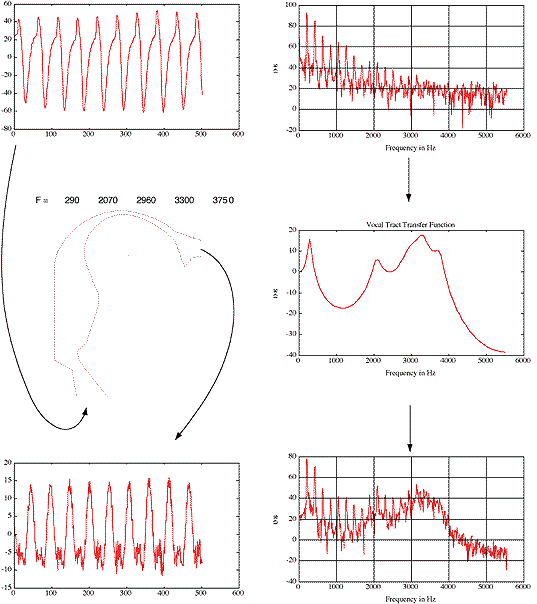Linguistics
120a/520a
General Phonetics
1. This demonstration is designed to show the waveform of a typical laryngeal source, and the result (both visually and auditorily) of filtering that source through a vocal tract filter function, or transfer function.
2. First examine the waveform envelope of the utterance ("mike"--Figure 1), and listen to it (by clicking on it). It was produced by a speaker of siSwat'i, a language spoken in Swaziland (in South Africa). A rough transcription is shown below the waveform. The speaker first says the English words "forty-five," followed by a siSwat'i word, that I would transcribe as [ut'ok|aba]. Note that during the voiceless intervals, there is very little amplitude in the signal. The amplitude is due primarily to the voiced source. Note that the [b] in [ut'ok|aba] is voiced, but because it is a closure, it too has little amplitude.
3. Figure 2 ("glottograph") shows the amplitude envelope of another recording that was made at the same time the subject spoke this phase. A device was placed on the subject's neck, called an electroglottograph (EGG) that measures the electrical resistance through the glottis, during periods when it is vibrating. When the glottis is open, resistance is high, when it is narrowed, resistance is low. Thus, there is large amplitude in the signal when the glottis is vibrating; it stays close to the midline when the glottis is not vibrating. As you can see, this separates the voiced from voiceless parts of a signal in a way that corresponds well to the microphone signal. Note that the interval corresponding to the [b] is not as reduced in the EGG signal as it is in the mike signal. That's because it is voiced; the reduction in amplitude in the mike signal is due to the action of the supralaryngeal vocal tract. When we play this signal out, it gives an idea of what the vibrating larynx would sound like if there were no changing supralaryngeal vocal tract sitting on top of it. That is, it is an approximation to the acoustic source , that will then be filtered by the shape of the superlaryngeal vocal tract. It is an approximation because it is a measure of electrical resistance, not the actual airflow through the larynx. But the patterns of resistance and airflow will be similar. Note that it is possible to perceive the global intonation pattern and rhythm of the sentence. Such aspects depend crucially on the laryngeal source, and how it changes over time, and less crucially on the superlaryngeal gestures.
4. Figure 3 shows a more detailed display of the mike and EGG
signals at the beginning of the [aI] in "five." Note that each
glottal pulse can be seen as a distinct closing and opening of the
glottis. This can be contrasted with the microphone signal for the
same point in time which is more complex: it includes the resonating
effects of the supralaryngeal vocal tract.
5. We can make the EGG sound like any vowel, by filtering it through
a set of resonances tuned to correspond to a particular vocal tract
shape. Every vocal tract shape has a characteristic filter or
resonance function, characterized by a set of resonance frequencies
or formants. For example, in Figure 4 we see the effect of
filtering the source through a shape appropriate for the vowel
/i/.

6. The bottom three panels below are the results of filtering the EGG
source though resonances (formants) appropriate for the vowels [a],
[i] and [u]. Click on each waveform below to hear the utterances they
represent. The images below show the expanded waveforms in these
panels, along with the EGG waveform at the top, at the same point in
time as for Figure 3 (beginning of the vowel [aI] in "five" ). Note
that the fundamental periods line up in all the panels (although they
are hard to see for [a]). This is because the fundamental period (and
frequency) is due to the glottal source. The shape of the complex
wave within each fundamental period differs from panel to panel. This
is due to the filtering action of the vocal tract.
